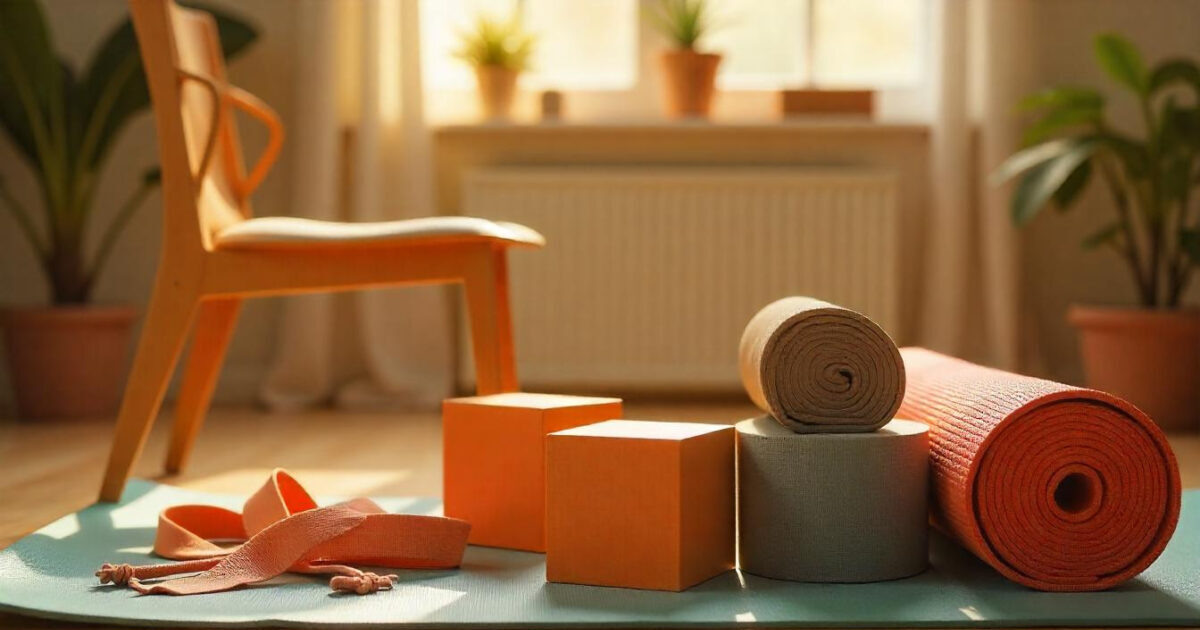Listen to a summary of this article:
Key Takeaway
Yoga improves seniors’ physical and mental health by building strength, flexibility, balance, and mood. Make safety and comfort a priority by selecting non-slip mats, supportive props, and adaptive tools. Yoga chairs provide additional support, while grippy anti-skid yoga socks and yoga straps make poses easier to master with better grip and flexibility. Always listen to your body, make modifications in poses as necessary, and maintain your gear for a safe and effective practice.
Contents
- 1 Why Yoga is Great for Seniors
- 2 Essential Yoga Equipment for Seniors
- 3 Choosing the Right Yoga Gear
- 4 Additional Yoga Resources for Seniors
- 5 Yoga Chairs for Seniors: Enhanced Support
- 6 Safety Considerations for Seniors
- 7 Maintaining Your Yoga Equipment
- 8 Wrapping It Up
- 9 Frequently Asked Questions
- 9.1 What yoga equipment is best for seniors with limited mobility?
- 9.2 Is a yoga mat necessary for seniors practicing yoga?
- 9.3 What type of yoga chair is suitable for seniors?
- 9.4 How often should seniors replace their yoga equipment?
- 9.5 Can seniors use regular yoga equipment?
- 9.6 Are there safety tips for seniors using yoga gear?
- 9.7 What are the benefits of yoga equipment for seniors?
- 9.8 Was this helpful?
Why Yoga is Great for Seniors
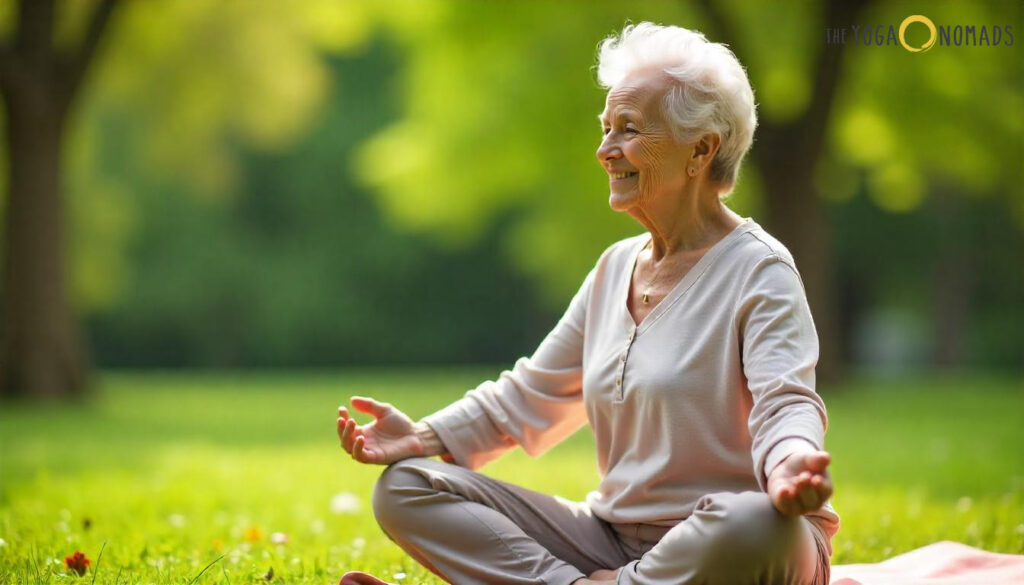
With proper guidance, yoga provides seniors with a realistic means of fostering greater physical and mental well-being. I had the personal experience of seeing my parents become avid practitioners of yoga, benefiting tremendously with increased mobility and a more active daily life. They’ve gained newfound mobility and have a more positive disposition.
It’s a gentle, yet challenging practice that can be adjusted to each individual, making it accessible to people of all abilities.
Improved Physical and Mental Health
Gentle yoga movements help seniors strengthen important core muscles that improve posture and overall mobility. Yoga’s targeted stretches can help manage chronic conditions such as arthritis and back pain by reducing inflammation and pain.
Breathing exercises calm the mind, while yoga improves concentration and focus while lowering anxiety levels. The emphasis on self-care creates a theme of positive growth that can be transformative for seniors adjusting to new lifestyles as they age.
Increased Flexibility and Balance
A consistent yoga practice improves joint flexibility, making everyday activities—like picking something up from the floor—easier. Balance-centered postures help prevent falls, a major concern for people over 60.
Additionally, yoga helps improve posture and alignment, relieving body stress and supporting mobility. Maintaining mobility in the body, specifically the major joints, helps seniors remain independent, enhancing their quality of life.
Social Interaction and Community
Joining group yoga classes helps seniors connect to the larger community. Whether through sharing progress updates or socializing after class, these exchanges help alleviate feelings of loneliness and isolation.
Community-centered classes create camaraderie, motivation, and accountability that encourages participants to return. Practicing together creates a collective experience of compassion and support, which is important for emotional well-being.
Essential Yoga Equipment for Seniors
Proper yoga equipment is crucial for developing a safe, comfortable, and effective yoga practice for seniors. It’s about supporting joint health and overall well-being. Before we get into specific recommendations, here are some general tips for seniors beginning a yoga practice
Prioritize Safety and Comfort with Essential Gear
For seniors, safety and comfort go hand-in-hand. Mats with a minimum 5mm thickness offer more comfort and support for vulnerable joints. Non-slip surfaces are crucial to prevent slipping, particularly in standing poses.
A thicker, textured mat can make all the difference between slipping and building confidence in your practice. Portability is also important—choose mats with built-in straps or carry handles for easier transport.
Practicing yoga in a chair is another way seniors can feel safe and comfortable while they move. Using chairs boosts confidence and enables adapting routines to individual needs, particularly benefiting those with mobility or balance issues and beginners alike.
Choosing the Right Materials
Yoga mats come in various materials, each catering to a specific interest. An eco-friendly mat made from natural cork or rubber gives you grip without toxins. Alignment-marked mats can help with posture and balance, making poses easier to hold.
Lightweight yoga blocks are another essential. They help adapt poses, provide extra stability, and are easy to carry around. For additional joint protection, lightweight knee and elbow pads can help.
Choosing the Right Yoga Gear
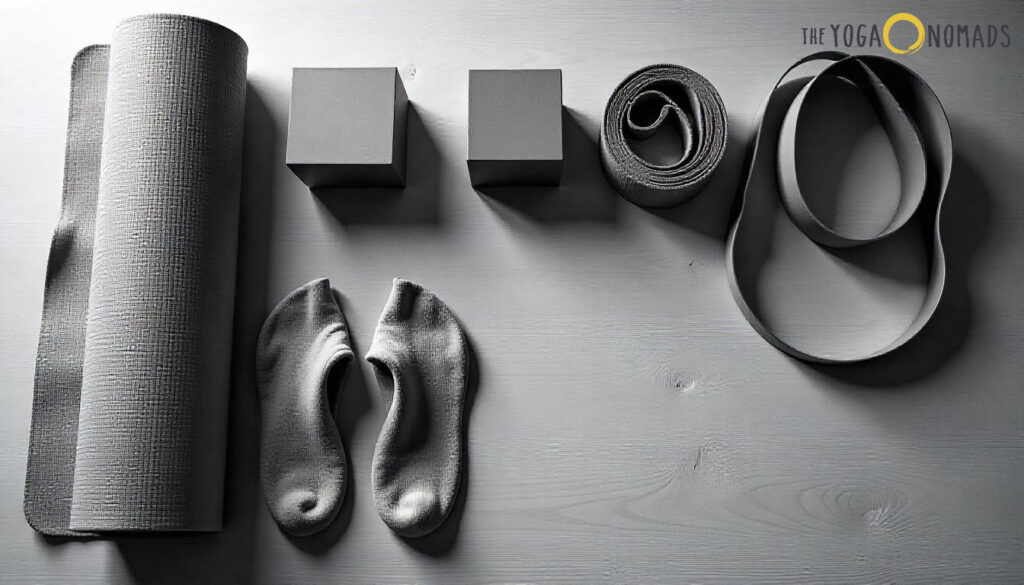
Choosing proper yoga gear, such as a yoga towel or blanket, can enhance your practice, making it safer and more enjoyable—particularly for seniors. From mats to props, each piece helps support your body through practice.
1. Yoga Mats: Thickness, Grip, and Durability
A good, dependable yoga mat is the backbone of any yoga practice. For seniors, a thicker mat—about 1/4 inch—provides added cushioning to safeguard vulnerable joints.
A good mat can help you feel safer and more confident during practice. The lululemon workout mat works wonders. Its 6mm thickness offers just the right amount of support and comfort.
Look for mats with a textured, non-slip surface for a solid grip when holding poses, especially on hardwood or tiled surfaces.
Durability should be considered as well. A mat that’s easy to maintain and can withstand daily use will last years and remain hygienic.
2. Yoga Blocks for Modified Poses
A yogis’ most versatile prop — on a mat or chair — is a good set of yoga blocks. Using blocks helps alleviate strain, enhance posture alignment, and make poses more accessible.
Their height is adjustable (4, 6, or 9 inches) so you can choose your level of support. By providing a stable surface, blocks can help you maintain balance in challenging poses and encourage proper alignment, reducing the risk of injury. Check out this one from lululemon.

lululemon Lift & Lengthen Yoga Block
3. Yoga Straps for Deeper Stretches
Yoga straps are ideal for improving flexibility. Using a strap can magically extend your reach in an instant, and adjusting the length gives support specific to your needs, especially for beginner yogis.
I find using straps especially helpful in restorative yoga sessions, helping maintain good alignment while stretching, avoiding strain, and promoting safe progress.
Check out a more detailed guide in our dedicated section on yoga straps.
4. More Equipment for Extra Support
Cushions and bolsters are great for restorative poses, relieving pressure on tired joints. They’re excellent for meditation and relaxation, helping support the body during longer holds. A yoga blanket is another essential prop tailored to comfort and relaxation, whether you’re practicing on a mat or on a yoga chair.
5. Yoga Leggings
The best yoga leggings for senior women focus on comfort, support, and flexibility. Choose high-waisted designs for a smoothing effect and security during movement. Lightweight, breathable, moisture-wicking fabrics keep you cool and comfortable. Select leggings that are either generously cut or provide plenty of stretch to flatter all shapes and sizes. The right pair enhances mobility while ensuring confidence and ease during practice.
Want to know more? Check out a thorough review here.
6. Non-Slip Socks For Enhanced Grip
Non-slip, traction-pattern socks are ideal for yoga practice where added stability is needed. Breathable, snug fits are best, and toeless or open-toe designs can provide greater flexibility without sacrificing grip. Check out this non slip socks on amazon.
COOLMATE Pilates Socks with Grips
See latest priceAdditional Yoga Resources for Seniors
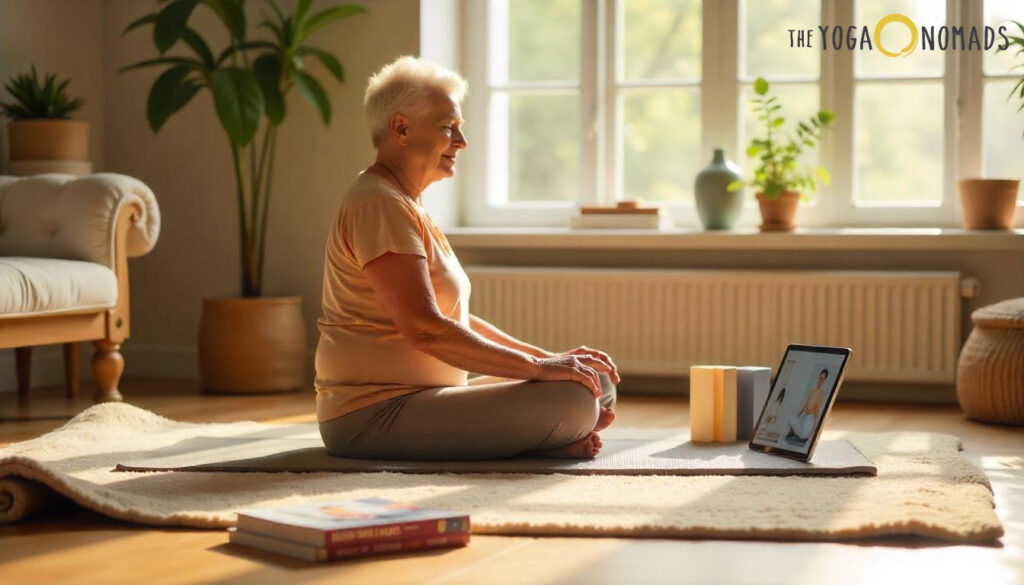
In addition to yoga accessories, seniors can find support in numerous other resources in print and online.
7. Chair Yoga Books for Seniors
Chair yoga books provide step-by-step instructions on practicing seated yoga safely and effectively. These books include detailed illustrated poses and modifications for various mobility levels, giving seniors independence to improve flexibility, balance, and relaxation on their terms. They provide inspiration for building individualized practices, making yoga accessible from the comfort of home.
Read our complete guide on it here.
8. Chair Yoga Apps for Seniors
Chair yoga apps provide instruction and guided routines with video demonstrations. They offer personalized workouts so users can enjoy yoga whenever works best for them. These apps provide clear instructions, progress tracking, and adaptations for various mobility levels, creating a safe and accessible experience. They’re a convenient way for seniors to stay active and improve flexibility from home.
Read our complete guide on it here.
9. Online Yoga for Seniors
Online yoga for seniors provides universal, equipment-free classes with guided instruction, allowing easy practice from home. With programs tailored to different fitness levels, seniors can choose sessions focusing on flexibility, balance, or relaxation. Most offer classes streamed live or on demand, giving students the freedom to participate at convenient times. This allows seniors to be active and healthier at their own pace.
Read our comprehensive guide on it here.
Yoga Chairs for Seniors: Enhanced Support

Chair yoga presents an attractive solution for seniors who want to practice restorative yoga with increased ease and support. Learn to comfortably incorporate regular chair practice into your routine to adapt standard poses while still experiencing yoga’s benefits.
With an appropriate yoga chair, you can approach your practice with more confidence without sacrificing safety.
Benefits of Chair Yoga
A simple chair is a fantastic tool to increase flexibility and strength, using seated poses to deepen stretches and build muscle strength. Yoga instructors often recommend this adaptive yoga style to their elderly clients.
Yoga builds strength, increases flexibility, and strengthens the core to improve balance and coordination, both of which are extremely important for fall prevention. Gentle chair-supported movements promote relaxation and mindfulness, creating a soothing environment for stress relief.
For seniors with mobility difficulties, chair yoga allows them to be more active in a safer, easier manner.
Features to Look For in a Chair
User safety should always be the top priority. Chairs made from strong materials, such as the tubular steel Backless Yoga Chair from Aozora, provide superior support and durability.
Double-hinged designs provide added strength, making them perfect for seniors. Lightweight options are key for transportation, and adjustable heights offer customizable comfort. Padded seats make chairs comfortable for longer periods without discomfort.
Safety Considerations for Seniors
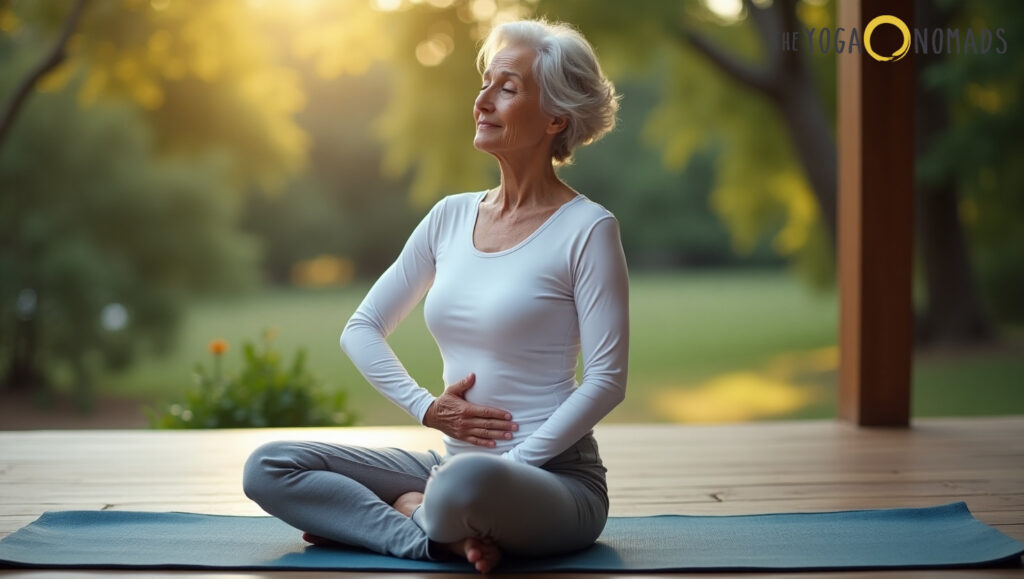
Safety is essential for all practices. We’ve covered how the right equipment will help keep you safe. After setting up your physical yoga space with the desired props, here are some other precautions seniors should keep in mind when taking up a yoga practice.
Consult a Healthcare Professional
Beginning with expert recommendation is important. I suggest speaking with your physician about any health issues before starting yoga.
They can provide specific advice, such as which poses to avoid if you have arthritis or osteoporosis. Research has found that specific yoga postures can increase spine and hip bone density.
With proper guidance, you can build a practice that keeps you safe and healthy.
Listen to Your Body
Listening to your body is perhaps the most important principle of yoga. Take time transitioning between poses and modify to what feels best. If you experience discomfort or fatigue while on your exercise mat, take a break.
Resting isn’t failure—it’s part of safe practice.
Modify Poses as Needed
Make poses more accessible using the amazing props like the yoga blanket and straps recommended here. Chair yoga provides excellent modification options as well, particularly when using a yoga bolster or blocks.
Finding alternatives means you can experience yoga’s benefits while staying within your comfort level.
Avoid Overexertion
Practice slow, controlled movements rather than focusing on distance or speed. Shorter, quality sessions are better than overexertion.
Quality in your practice is more important than quantity.
Maintaining Your Yoga Equipment
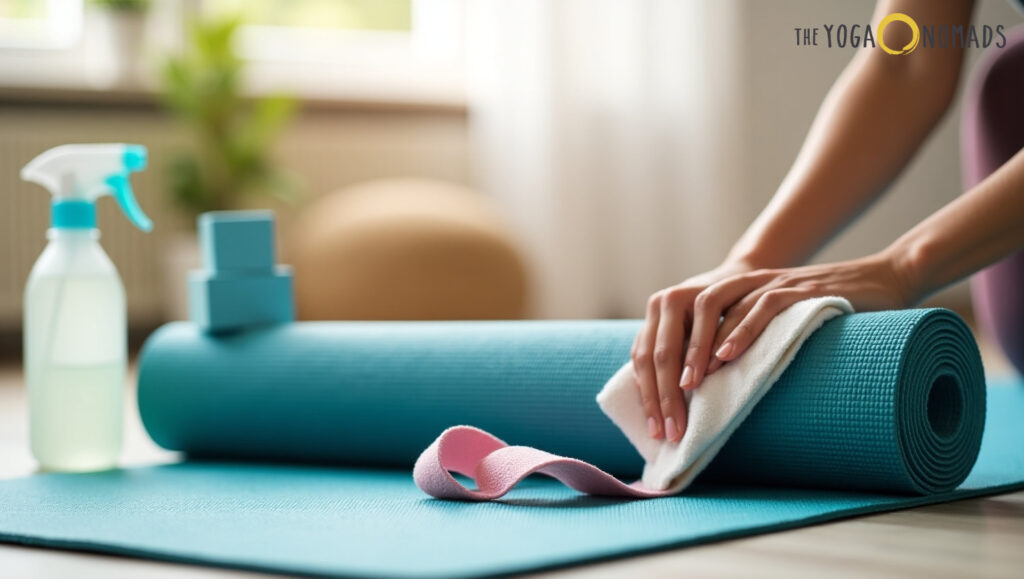
Taking good care of your equipment ensures longevity and safe, hygienic practice. Small maintenance steps go a long way in extending gear life. This is especially important for seniors who rely on supportive mats and props for accessibility.
Cleaning and Storage Tips
Regularly clean your practice space, especially your mat, for safety and hygiene. I use a mix of mild soap and water to wipe down my mat after each session. A simple spot clean with a damp cloth works well, too.
Always air dry mats completely to prevent mildew and odors, especially if they’re made from a good mat material. This is particularly important for natural rubber mats, which may have an initial rubbery smell that dissipates after a few weeks. Check the manufacturer’s cleaning instructions to protect the mat’s quality and durability.
For storage, roll mats loosely to prevent creases. Store them in a cool, dry place, away from sunlight. Keep blocks and straps organized but accessible.
From experience, I’ve found that organizing equipment this way helps maintain a calm, inviting space.
Inspecting for Wear and Tear
Frequent equipment inspections are important for safety. Check mats for thinning or cracking. Most can last up to 10 years with proper care.
Replace mats when their grip begins to fail. Inspect props for frayed straps or chipped blocks, and replace anything that might compromise stability. Prioritizing equipment condition greatly reduces injury risk during practice.
Wrapping It Up
Yoga can be transformative for seniors, helping them maintain independence through restorative yoga practices. Investing in quality yoga gear means investing in comfort, safety, and practice quality. Whether it’s supportive chairs, soft mats, or blocks, each piece enhances your routine. It’s about finding what works for you, not following rigid rules. The right tools, including a good mat, allow for safe, successful movement.
Regular maintenance ensures your equipment remains dependable for years! Small changes can keep your practice fresh and engaging.
Research, shop for quality gear, and create an environment that works for you. Yoga isn’t merely exercise—it’s a path to improved health, stability, and mental serenity.
Pop quiz! 🧘🤔
Yoga chairs are specifically designed to support seniors in performing yoga poses safely and comfortably.
All seniors should avoid any form of yoga, as it is too strenuous for their bodies.
Using yoga equipment can enhance the yoga practice for seniors by providing added stability and support.
Frequently Asked Questions
What yoga equipment is best for seniors with limited mobility?
A sturdy yoga chair and blocks are great tools for seniors with mobility difficulties. They help to deepen stretches, open up the body, develop balance, and can be used to modify poses to meet individual needs.
Is a yoga mat necessary for seniors practicing yoga?
If practicing traditional or restorative yoga, yes, a yoga mat with some extra padding should be to your liking. It helps to avoid falls, it helps to support the joints, and it gives you a secure surface to practice yoga on.
What type of yoga chair is suitable for seniors?
An armless, solid-base chair with a non-skid bottom works great. With safety and comfort in mind, look for a chair designed for yoga to support senior students in seated poses.
How often should seniors replace their yoga equipment?
If you practice multiple times a week, mats should be replaced every 6–12 months. Other accessories, such as blocks or straps, will not wear out as quickly, but make sure to monitor them for signs of wear and tear.
Can seniors use regular yoga equipment?
Yes, yes, a thousand times YES! For seniors, you’ll want to choose equipment that provides stability and comfort. Ideally, you would find thicker mats and adjustable straps to address their individual needs.
Are there safety tips for seniors using yoga gear?
Make sure to regularly check any equipment for stability and signs of wear before using it. When practicing, do so on safe, non-slip surfaces, and do not overexert yourself, especially during hot yoga sessions. Having the right gear can help decrease your risk of injury.
What are the benefits of yoga equipment for seniors?
Whether it’s a block, strap, or chair, yoga props increase stability, deepen flexibility, and allow seniors to execute poses safely and comfortably. It helps maintain correct posture and prevents overextending or stressing the joints and muscles.


